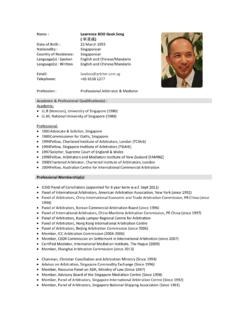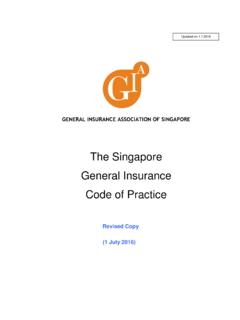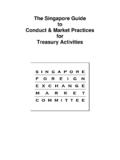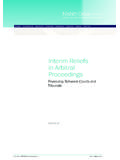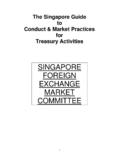Transcription of SINGAPORE TAX 2017 - Iyer Practice
1 SINGAPORE TAX 20172 | SINGAPORE Tax 2017 Types of Doing Business / Legal Forms of CompaniesGenerally businesses can carry out business in SINGAPORE either through the incorporation of a limited liability company (Private Limited or Limited) or through the registration of a branch of the foreign business in SINGAPORE . Foreign businesses can alternatively setup a Representative Office in SINGAPORE with approval from International Enterprise SINGAPORE for a maximum of 3 years from the commencement date. The activities of a Representative Office are restricted to conducting market research and feasibility studies. Businesses can also carry out business as sole propriertorships and partnerships (including limited liability partnerships). Corporate Income Tax Basis of TaxationSingapore taxes businesses on a preceding year basis on SINGAPORE sourced income and on foreign sourced income received in SINGAPORE .
2 Whether income is considered as foreign sourced is dependent on the facts and circumstances of each case. Receipt does not only include receipts into a SINGAPORE bank account but also other circumstances defined under the SINGAPORE Income Tax Act. The prevailing corporate tax rate is 17%. A partial tax exemption is given to companies on normal chargeable income: AMOUNT OF CHARGEABLE INCOMEEFFECTIVE TA X RATEF irst S$10, S$290, excess of S$300,00017. 0 0 %ExemptionsFull tax exemption on the first S$100,000 and a 50% exemption on the next S$200,000 of chargeable income is available for a start-up company (including companies limited by guarantee) which has no more than 20 shareholders of which at least one individual shareholder holds at least 10% of total number of issued ordinary shares. This exemption is only available for the first 3 consecutive Years of Assessment (YA).
3 However, this exemption is not available to investment holding companies and property developer companies. Foreign-sourced dividends, branch profits and service fee income received in SINGAPORE are exempted if the income has been subject to tax in a foreign jurisdiction where the headline tax rate is 15% or more, subject to Tax Rebate (Temporary)A corporate income tax rebate of 50%, capped at S$25,000, will be granted to all companies for YA 2017 . The above rebate will be extended to YA 2018 at a reduced rate of 20%, capped at S$10, SINGAPORE resident company means a company, the control and management of whose business is exercised in SINGAPORE . Companies that wish to obtain a Certificate of Residence (in order to obtain tax treaty benefits) must ensure they meet the substance requirements required by the IRAS. Withholding TaxAMOUNT OF CHARGEABLE INCOME%Dividends0 Interest, commission, fee or other payment in connection with any loan or indebtedness 15*Royalty or other lump sum payments for the use of movable properties10*Payment for the use of or the right to use scientific, technical, industrial or commercial knowledge or information10*Technical assistance and service fees/management fees17#Rent or other payments for the use of movable properties 15*Charter fees for aircraft2 Charter fees for ship0 Directors remuneration22 Proceeds from sale of real property by a non-resident property trader 15 Branch remittances0* The withholding tax at 10% or 15% on the gross payment is a final tax unless the income is derived through operations carried out in or from SINGAPORE , when the rate is 17%.
4 # Applicable only if services are rendered in Tax 2017 | 3 Where a double tax agreement (DTA) is applicable, the rates specified in the agreement with the respective country would apply, if the rates are lower than the actual domestic normally provide tax credits for foreign tax suffered against the domestic tax imposed on the same income. SINGAPORE residents can also elect for foreign tax credit pooling tax credits will be extended to SINGAPORE residents on all types of foreign-sourced income remitted into Taxation Agreements (DTA) SINGAPORE currently has 81 tax treaties that are in force. In addition, treaties with Cambodia, Ethiopia and Uruguay have been signed but are not yet effective and revised or renegotiated treaties with Sri Lanka and India have been signed but are not yet effective. Please refer to the Appendix for the tax rates in respect to dividend, interest and royalties for the respective countries with an applicable DTA with SINGAPORE .
5 Common Reporting Standard (CRS)Automatic exchange of information ("AEOI") based on the CRS refers to the regular exchange of financial account information between jurisdictions for tax purposes, with the objective of detecting and deterring tax evasion by taxpayers through the use of offshore bank accounts. SINGAPORE has committed to implement the CRS, with the first exchange to take place by September 2018. Transfer PricingWhere the pricing of Related Party Transactions ("RPT") is not at an arm's length and results in a reduced profit for the SINGAPORE taxpayer, SINGAPORE may adjust and tax the profit of the SINGAPORE taxpayer under Section 34D of the SINGAPORE Income Tax Act. The SINGAPORE tax authority has issued transfer pricing guidelines that cover the application of the arm's length principle, documentation requirements, advance pricing agreements and requests to invoke the mutual agreement procedure under SINGAPORE 's tax treaties.
6 Generally, taxpayers are required to prepare and keep transfer pricing documentation on a contemporaneous basis (ie. based on information and documentation prior to or at the time of undertaking the transactions) for related party transactions that exceed the following thresholds: CATEGORY OF RELATED PARTY TRANSACTIONSTHRESHOLD (S) PER FINANCIAL YEAR (S$)Purchase of goods from all related parties15 millionSale of goods to all related parties15 millionLoans* owed to all related parties15 million Loans* owed by all related parties15 millionAll other categories of related party transactions (eg. service income, service expense, royalty income, royalty expense, rental income, rental expense, guarantee income, guarantee expense) on an aggregated basis. 1 million per category of transactions*When taxpayers lend money to or borrow money from their related parties.
7 From YA 2018, taxpayers must report certain details of RPT if the value of RPT in the audited accounts for the financial year exceeds S$15 million. The Form for reporting RPT should be submitted togehter with the submission of Form C of the tax return. As a Base Erosion and Profit Shifting ("BEPS") Associate, SINGAPORE will implement Country-by-Country Reporting (CbCR) for financial years beginning on or after 1 Jan 2017 for multinational enterprises whose ultimate parent entities are in SINGAPORE and whose group annual turnover exceeds S$1,125 million. The SINGAPORE tax authority will exchange Country-by-Country reports with jurisdictions that SINGAPORE has entered bilateral agreements with automatic exchange of CbCR information. Loss Carry Over (including potential loss of tax loss carry forward in case of restructuring)Losses may be carried forward indefinitely, subject to the shareholding test.
8 Unutilised capital allowances carried forward are subject to both the shareholding test and a "same business" test. Current unutilised losses and capital allowances may be carried back for one year, subject to a cap of S$100,000 and the shareholding test. When current year unutilised capital allowances are carried back, the same business test also must be satisfied. 4 | SINGAPORE Tax 2017 Group TaxationSingapore does not have a consolidated tax regime. However, group relief allows the transfer of unutilised losses, unutilised capital allowances and unutilised donations from one qualifying company to be offset against the taxable profits of another qualifying company within the same qualify, companies must be incorporated in SINGAPORE and be at least 75% owned by another company in the group that is incorporated in SINGAPORE , and must have the same accounting year end.
9 Capital AllowancesCapital allowances can be claimed on expenditure incurred on qualifying "plant and machinery" for use in a company's trade or of computing capital allowances for qualifying assets are as follows: ASSET TYPEPERIOD (YEARS)Low-value assets (less than or equal to S$5,000)1 Specialised equipment (Write off over the prescribed working life of the assets)5 16 PIC assets (See below)1 year + 300% unless cash payout option is exercisedAll other assets3 Productivity and Innovation Credit (PIC) SchemeBusinesses are able to claim tax deduction / allowances of up to 400% of qualifying expenditure incurred with a cap of S$400,000 for each specified activity up to YA 2018. The qualifying expenditure cap is increased to S$600,000 for qualifying SMEs. Businesses may also choose to claim a 40% cash grant for up to S$100,000 of qualifying expenditure subject to conditions*.
10 The PIC scheme will not be available after YA 2018. Qualifying Activities Under PIC Scheme Purchase/Leasing of IT and Automation Equipment Training of employees R&D Activities Purchase of IP Rights Registration of IP Qualifying design projects*Cash Payout Eligibility Active business operations in SINGAPORE At least 3 local employees who have contributed CPF Qualifying equipment has been used by the business Renovation and Refurbishment Deduction SchemeA special tax deduction is granted for expenditure on all fixtures, fittings, and installations (attached fixtures), except those expenses relating to structural works and expansion of space. This deduction is given over a period of 3 consecutive years and is subject to a cap of S$300,000 for each 3 year period. Double Tax Deduction for Internationalisation (DTDi) SchemeBusinesses are able to claim a 200% tax deduction on qualifying expenditure incurred on qualifying market expansion, investment development activities and manpower expenses, subject to conditions.




